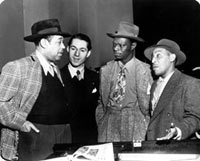Career
Leonard Feather was held in high esteem in the jazz world. His involvement with the industry spanned six decades and his list of accomplishments was impressive. He was involved in almost every aspect of the music industry.
Feather was not an artist manager or talent promoter. When he was once characterized as a manager he pushed back, reflecting that not only was he not managing others, but he could have used a good manager himself.
Feather did work as a press agent from 1941 to 1943, but he was never really a publicist. After less than three years he gave up his two remaining accounts, Duke Ellington and Lionel Hampton, and returned to his journalism work. He later did not even like being reminded he had ever been in the publicity game. Feather had a hand in almost every aspect of jazz music: journalist and critic, arranger and producer, musician and author, teacher and historian. His talent and extensive contributions went into records, concerts, radio, television, movies, books, and periodicals.
Awards:
- 1964—First Grammy award given by National Academy of Recording Arts & Sciences for album notes (The Ellington Era)
- 1971—Nominated for an Emmy for producing ‘The Jazz Show’, a series seen on KNBC, Los Angeles
- 1978—Corporation for Public Broadcasting award for excellence in local programming on ‘The Leonard Feather Show’, KUSC, Los Angeles
- 1981—Citation from Mayor Tom Bradley and L.A. City Council at a banquet organized by Harold R. Udkoff to establish Leonard Feather scholarships at the Duke Ellington School of Arts in Washington, DC
- 1983—International Critics’ Poll, Down Beat magazine: Lifetime Achievement award
- 1984—Awarded honorary doctorate of music at Berklee College of Music in Boston
- 1985—Greater Los Angeles Press Club Journalism award: Certificate of excellence in entertainment reporting, Los Angeles Times
- 1986—National Association of Jazz Educators award for fifty years of contribution to jazz education and journalism

